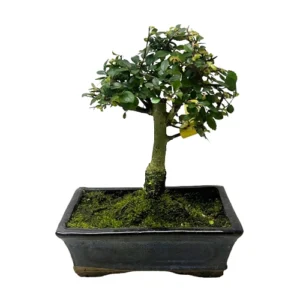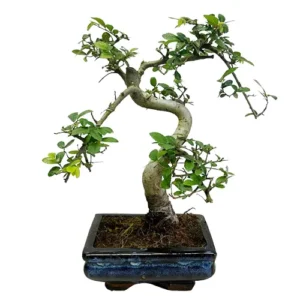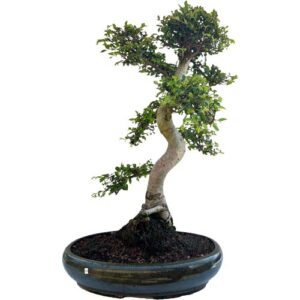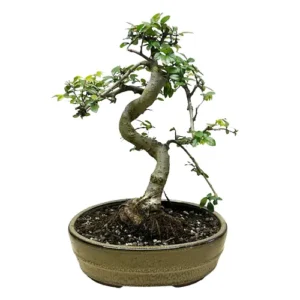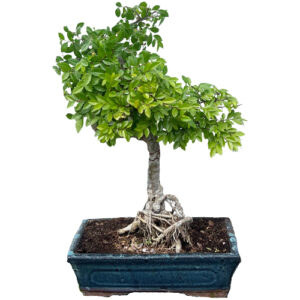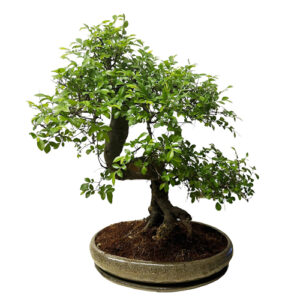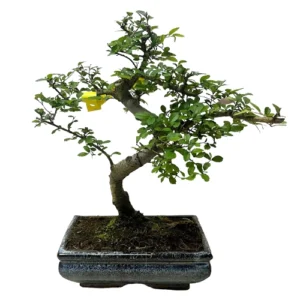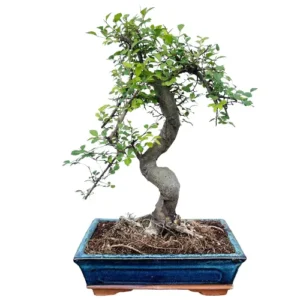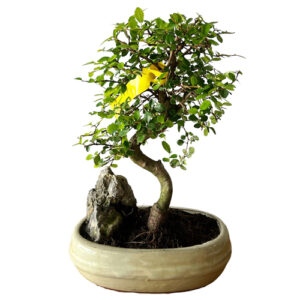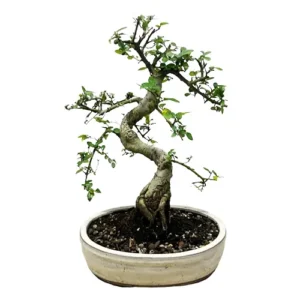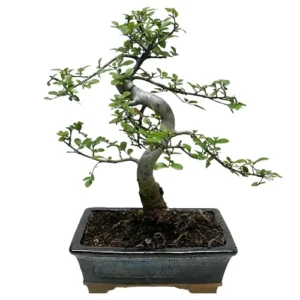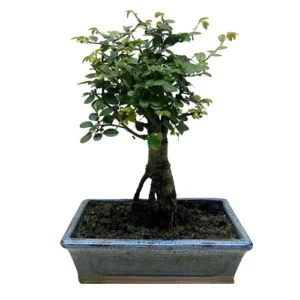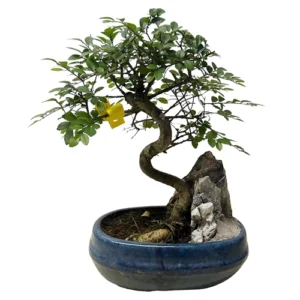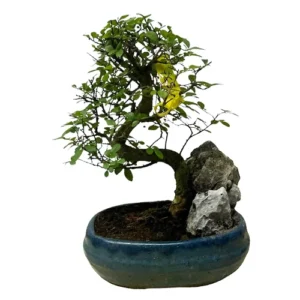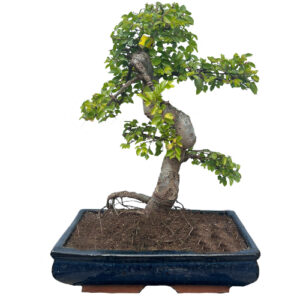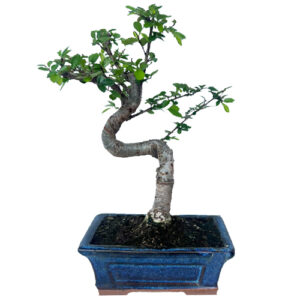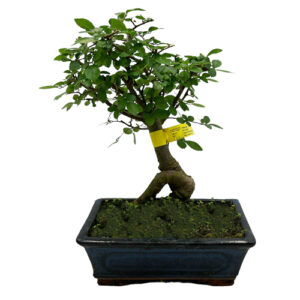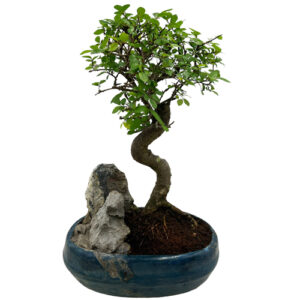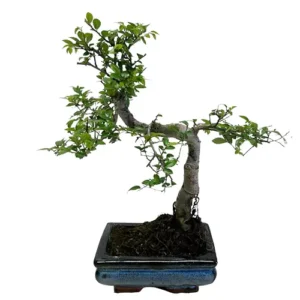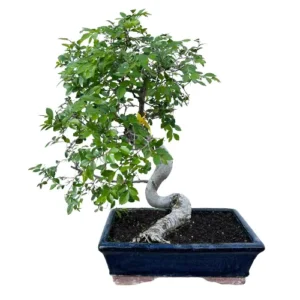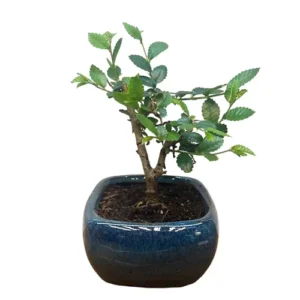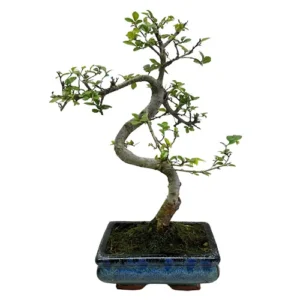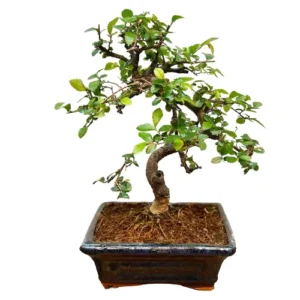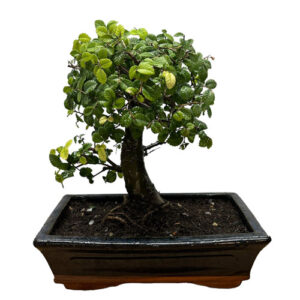Ulmus Parvifolia
Chinese Elm Bonsai
The Chinese elm is popular with beginners and collectors alike because it is very adaptable as well as satisfying to train. They develop fine ramification relatively fast through pruning. It is native to southeast Asia and makes an ideal tree species for bonsai because of its small leaves which are light green and slightly serrated.
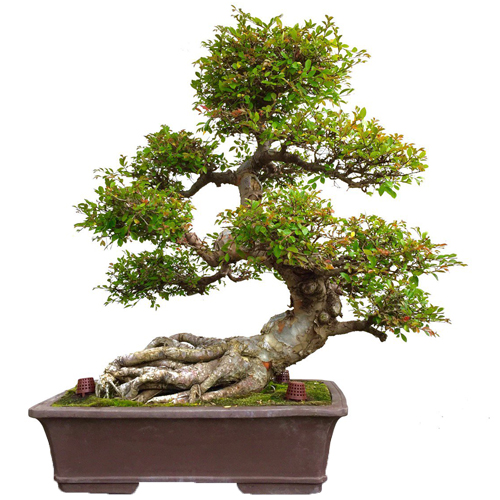
Chinese Elm Bonsai Care Guidelines
Placement
The Chinese elm can be kept as an indoor or outdoor bonsai. They can be placed in either full sun and/or partial shade. If placing inside, the Chinese elm should be positioned in a cool room away from central heating and kept humid. Your elm can be kept indoors all year round, but its growth and health would benefit from the extra sunlight and airflow that the summer months bring, so consider placing outside once it gets warm and sunny. This will help the growth of smaller, tighter leaves as well as avoid the dryness of a hot windowsill.
Chinese elms can also be left outdoors even during winter months and can usually tolerate some frost, but this differs depending on its previous climate. However, it is best to put it into a frost-free room such as an unheated greenhouse or a cold frame in the winter to avoid any problems. If you decide to keep your Chinese elm outside all year round then you will see it drop its leaves in winter, and they will start to re-grow around spring. Indoor elms should hold some leaves through the winter if not all its foliar.
Watering
There is no definitive guide to watering and it should be conducted on an observational schedule, not a routine. This means that it is important to keep an eye on the moisture levels of the soil to avoid over and under watering, both which can lead to dropping leaves and/or root death. The amount of water a bonsai requires depends on pot size, climate, airflow, soil and tree type so it is best to use your eyes and fingers to assess whether the soil is damp, wet or dry.
If the top inch or so of soil has dried, it is ready to be watered. When you water, try to get an even coverage over the roots and soil, allowing water to flow out from the bottom of the pot to ensure a good soaking.
If you are a first-time bonsai owner, another way to water is by submerging the entire pot in water until the bubbles stop. If you choose this method, be aware that your bonsai may not need watering for another two to four days, but this will depend on the factors mentioned above such as soil type, pot size and climate.
The Chinese elm also benefits from higher humidity levels. This can be achieved by using a mister to spray the leaves, as well as placing a gravel tray under the pot to create a more humid microclimate around the tree.
Feeding & Fertilising
Using fertiliser on your Chinese elm will help encourage healthy growth and this should be done periodically from once a week to every two months and only during the growing season. You can start adding Chrysal Liquid Bonsai Feed to your water from March until October and use weekly. Use Naruko Fertiliser Slow Release Bonsai Feed once every one to two months. With Buddhist Pine trees, less is more, and we tend to advise using half the recommended dosage to see how your Buddhist Pine reacts first.
Pruning & Wiring
Pruning your bonsai is important not only to maintain or create an aesthetic style but to also ensure light and airflow can reach inner foliage. The Chinese elm thickens rapidly and will grow fast if left unchecked. Frequent trimming will produce a dense network of fine branches (ramification) and it responds well to hard pruning. To do this, during the late autumn months, use appropriate tools to cut back stems which have grown longer than three or four leaves, leaving the two leaves which are closest to the stem intact.
Training your bonsai using wiring is best done during the late autumn dormancy period and the Chinese elm is especially rewarding to work with. We recommend using wires with a thickness that matches the thickness of the branch: if the wire you choose is too thick you will damage the bark. If it is too thin, it won’t be effective.
Repotting
Repotting your tree is an important way to provide a fresh and suitable soil mix and ensure appropriate root health. Repot in early spring. Generally, your Chinese elm will need to be re-potted once every two years if it is young, while older ones can stay in their pots for longer. However, you should always check if it has become root-bound before you change pots. You can do this by lifting the tree gently out of the pot by the main trunk and examining the root system. You will know it is ready if you can see that the roots are circling around each other and the pot. If, however, they still appear contained in the soil, you should place it back and wait until the following spring to check again.
Trees that are ready for repotting will require root pruning, a suitable new pot and appropriate soil mix.
When repotting, do not cut back the root mass by a large amount, and choose a well-draining soil mix that has a neutral or slightly higher PH value of 5-6 but not over 7. We tend to use a mixture of different speciality bonsai soils on our trees. Every species is different so please contact us for free soil-mix advice or to take advantage of our repotting service.
Bonsai make for a one-of-a-kind indoor plant offering elegance, nature and art all in one minute form. Across an array of exquisite and erudite species, they all demand their own specific care and cultivation needs in order for their beauty to flourish. We have an extensive library of care guides for indoor bonsai trees so you can make an informed and considered choice. It’s not about selecting the perfect bonsai, it’s about selecting the perfect bonsai for you.
Chinese Elm Bonsai - Typical Queries
Are Chinese Elm Bonsai good for beginners?
Yes, Chinese Elm Bonsai are one of the best choices for beginners, as they are easy to care for, resilient, and tolerant of mistakes. They can be kept indoors or outdoors, depending on the season and the temperature. They also respond well to pruning and wiring, which allows you to shape them according to your preference.
How much sunlight does my Chinese Elm Bonsai need?
Your Chinese Elm Bonsai needs plenty of bright, indirect sunlight to thrive. If you keep it indoors, place it near a sunny window, but avoid direct sunlight that can scorch the leaves. If you keep it outdoors, choose a spot that gets morning or afternoon sun, but not midday sun. You can also move it to a shaded area during the hottest hours of the day.
How do I propagate my Chinese Elm Bonsai?
You can propagate your Chinese Elm Bonsai by taking cuttings or by air-layering. Cuttings are small pieces of stem or branch that are planted in moist soil and kept in a humid environment until they develop roots. Air-layering is a technique that involves making a cut in the bark, wrapping it with moist sphagnum moss and plastic, and cutting it off when roots appear. Both methods are best done in spring or summer, when the tree is actively growing.
What are the common pests and diseases that affect my Chinese Elm Bonsai?
The most common pests and diseases that affect your Chinese Elm Bonsai are spider mites, scale insects, aphids, mealybugs, fungal infections, and bacterial infections. You can prevent and treat these problems by keeping your tree healthy, clean, and well-ventilated. You can also use organic or chemical pesticides and fungicides, but make sure to follow the instructions and apply them sparingly.
Why are the leaves of my Chinese Elm Bonsai turning yellow and falling off?
There are several possible reasons why the leaves of your Chinese Elm Bonsai are turning yellow and falling off. One reason is that the tree is going through a natural process of leaf shedding, which happens in autumn or winter, depending on the climate. Another reason is that the tree is stressed by overwatering, underwatering, overfertilizing, underfertilizing, or temperature changes. A third reason is that the tree is infected by a pest or a disease, which can cause leaf spots, wilting, or curling. To identify and solve the problem, you should check the soil, the roots, the branches, and the leaves for any signs of damage or disease. You should also adjust the watering, fertilizing, and lighting accordingly.
Why are black spots appearing on my Chinese Elm Bonsai leaves?
Black spots on your Chinese Elm Bonsai leaves are usually a sign of a fungal infection, such as anthracnose or black spot. These infections are caused by spores that land on the leaves and germinate in moist conditions. They can spread quickly and affect the health and appearance of your tree. To prevent and treat fungal infections, you should keep your tree in a well-ventilated area, avoid wetting the leaves when watering, remove any infected leaves and branches, and apply a fungicide spray or a homemade solution of baking soda and water.

